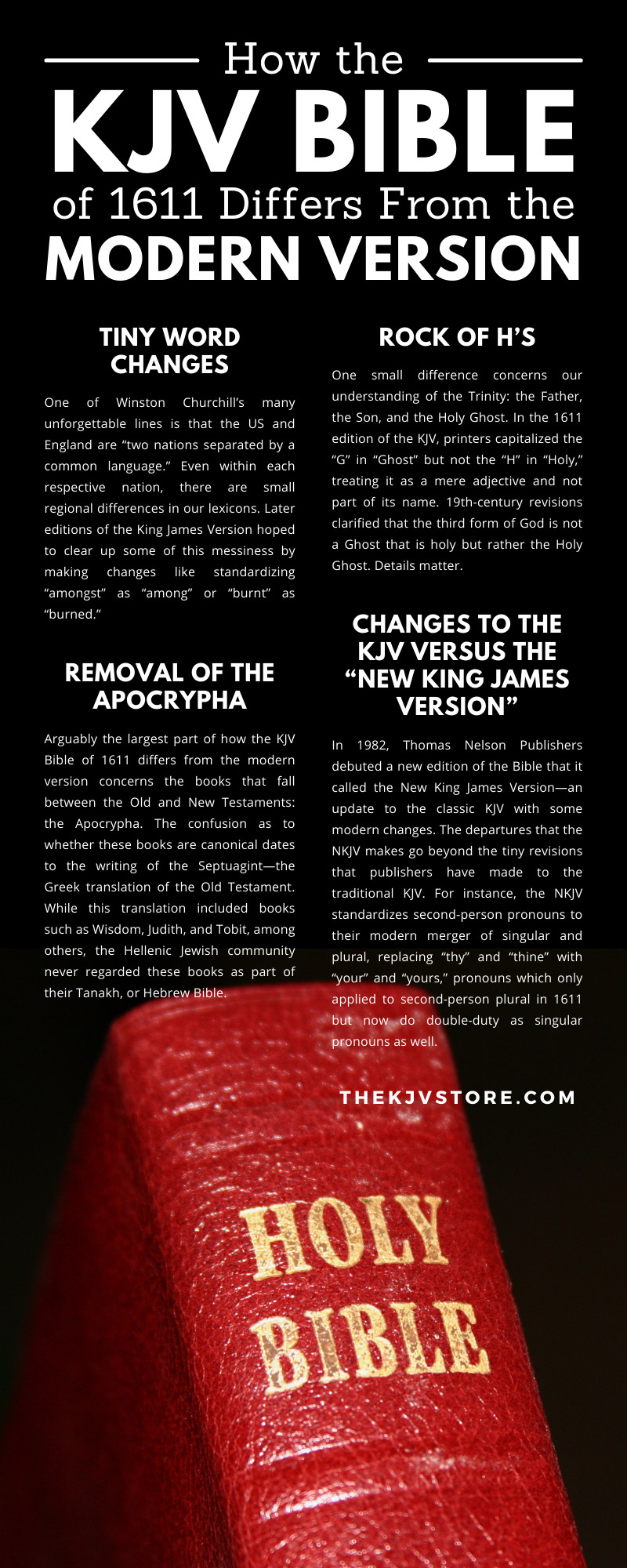How the KJV Bible of 1611 Differs From the Modern Version

The shelves of any bookstore, Christian or otherwise, will feature dozens of versions of the Bible. Though they claim to work from many of the same source materials, their translation strategies and editorial approaches will yield very different prose. Some translations of the Bible take such liberties with their interpretations that theologians will consider them more paraphrases than true translations—a severe indictment of those versions’ faithfulness to Scripture.
To avoid the ambiguities and misinterpretations that so commonly accompany more relaxed translations of the Bible, many readers prefer to stick to not just the classics, but the classic: the King James Version of the Bible, the English language’s first officially authorized version, an edition that made its debut in 1611. The theologians and translators whom James VI & I convened to create this masterpiece favored an approach to translation that we call “formal equivalency.” This describes a word-for-word translation that stays as true to each word of the original text as possible, even when that means sentences are more challenging than everyday prose.
Owing to its four-century legacy as the premier English edition of the Bible and its preservation of features like archaic English pronouns, many readers believe that no one has since dared to mess with perfection. They believe that the King James Version of 1611 is identical to the King James Version that publishers make available today. This is true—to an extent. However, a King James Version that is not explicitly a 1611 edition will feature some small differences and distinctions. We’ll explain how the KJV Bible of 1611 differs from the modern version of today and help you decide which iteration of the KJV best suits you.
Tiny Word Changes
One of Winston Churchill’s many unforgettable lines is that the US and England are “two nations separated by a common language.” Even within each respective nation, there are small regional differences in our lexicons. One of these ambiguities is the “-st” suffix, which appears inconsistently. Consider “while” versus “whilst,” “among” and “amongst,” or “amid” and “amidst.” Similarly, there is “-t” for past-tense words rather than “-ed,” leading to confusion between “burned” and “burnt,” or “spelled” and “spelt.” Later editions of the King James Version hoped to clear up some of this messiness by making changes like standardizing “amongst” as “among” or “burnt” as “burned.”
Rock of H’s
One small difference concerns our understanding of the Trinity: the Father, the Son, and the Holy Ghost. In the 1611 edition of the KJV, printers capitalized the “G” in “Ghost” but not the “H” in “Holy,” treating it as a mere adjective and not part of its name. 19th-century revisions clarified that the third form of God is not a Ghost that is holy but rather the Holy Ghost. Details matter.
Removal of the Apocrypha
Arguably the largest part of how the KJV Bible of 1611 differs from the modern version concerns the books that fall between the Old and New Testaments: the Apocrypha. The confusion as to whether these books are canonical dates to the writing of the Septuagint—the Greek translation of the Old Testament. While this translation included books such as Wisdom, Judith, and Tobit, among others, the Hellenic Jewish community never regarded these books as part of their Tanakh, or Hebrew Bible. While the Catholic Church has considered the Apocrypha deuterocanonical, or part of a “second canon,” Protestants have not deemed them worthy of inclusion. As the King James Version became a definitive Protestant edition of the Bible, editors of the KJV would later excise the books of the Apocrypha themselves as well as any references or footnotes regarding them, further reinforcing the divide between Catholic and Protestant interpretations of Scripture. Though KJV editions for a Catholic readership have reached bookshelves, in a sense bringing the KJV full circle, most modern KJVs omit the Apocrypha or resign it to an appendix.
Changes to the KJV Versus the “New King James Version”
In 1982, Thomas Nelson Publishers debuted a new edition of the Bible that it called the New King James Version—an update to the classic KJV with some modern changes. The departures that the NKJV makes go beyond the tiny revisions that publishers have made to the traditional KJV. For instance, the NKJV standardizes second-person pronouns to their modern merger of singular and plural, replacing “thy” and “thine” with “your” and “yours,” pronouns which only applied to second-person plural in 1611 but now do double-duty as singular pronouns as well. While this can appear to make things clearer for modern readers, it actually obfuscates the original meaning of the text. In Exodus 16:28, concerning God’s frustration with his chosen people upholding the Ten Commandments, God asks Moses, “And the LORD said unto Moses, How long refuse ye to keep my commandments and my laws?” While “ye” as second-person plural makes it clear to educated readers that it is the Israelites who are in violation of the Decalogue, a revision to “you” muddles this, making it seem as if Moses himself has broken the Commandments. You can learn more about these differences in our entry concerning the release of the New King James Version and why what’s new isn’t necessarily what’s true.
Finding the Right KJV for You
Whether you would prefer to read the King James Version with the minute changes and clarifications that have come with time and additional proofreading is up to you. The KJV Store offers both the modern and slightly amended King James Version as well as the original 1611 version. This is important: understand that if a King James Bible does not carry the clear label of being a 1611 edition, it is likely to contain the series of small changes we have discussed. Because reading any edition of the King James Version can be a daunting task for readers, the KJV Store also offers large-print and wide-margin KJV Bibles for readers who want additional space to annotate their copies or who struggle to read the infamously small type in most Bibles. And while the text may be more challenging than modern editions, this time-honored reading experience is a reliably rewarding one.

